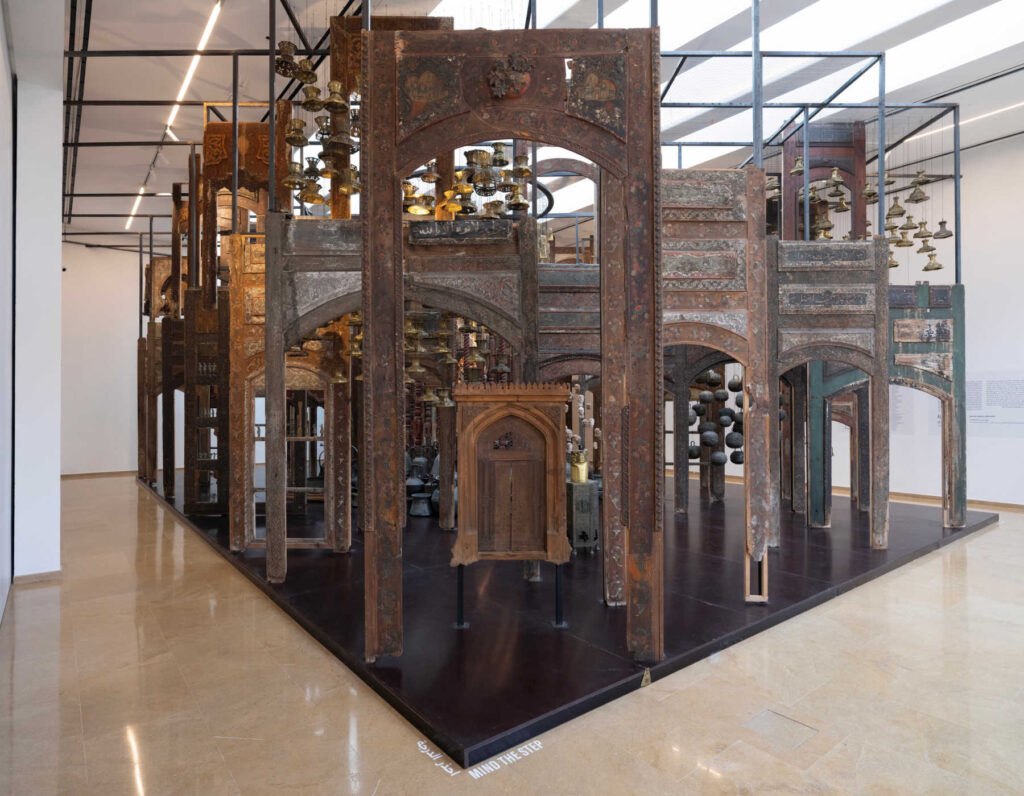Art dealer Saleh Barakat, a fixture in the city since 1990, said that his gallery was actually closed only during the first week of Israeli bombing, but then it reopened gradually. “Actually there were a lot of people who called us to visit the gallery and said they wanted a change of air,” he told me. The gallery became a meeting place, rather than just a space for art. “Artists, collectors and other people in the artistic community, we were concerned about the war and the gallery became a place where people would come to discuss and share,” Barakat said.
Although the formal opening was postponed, the National Museum of Beirut and its new annex remained open throughout the weeks of relentless Israeli bombardment. The inaugural exhibition at the new Nuhad es-Said Pavilion, titled “Portals and Pathways: A Journey Through Reality and Imagination,” was curated by the Beirut Museum of Art, or BeMA, a new museum that has been in development for many years, with a mission to preserve Lebanese heritage and culture through modern and contemporary art. Juliana Khalaf, BeMA’s co-director, said that while the ceremony to open the new pavilion “was understandably canceled, the Nuhad Es-Said Pavilion and BeMa remained unwavering in their commitment to keeping the space open.”
“Even amid such extraordinary adversity, we honored our promise to offer sanctuary—a place where shared heritage and collective imagination could defy the silencing grip of violence,” Khalaf said. The exhibition is a multigenerational showcase of Lebanese art, including modernist pioneers such as Saloua Raouda Choucair, Yvette Achkar, Jean Khalife and the painter Samia Osseiran Jumblatt, who died at 80 earlier this month. Established artists such as Lamia Joreige and Fouad El Khoury are shown alongside younger artists like Alfred Tarazi, Danielle Genadry and Rayyane Tabet. While BeMA is both a private NGO and future museum with a new building set to rise near the National Museum, it is also the official caretaker of Lebanon’s national collection of modern art, many works from which have never been shown to the public before.

Alfred Tarazi’s large-scale installation, “Hymne a L’Amour,” draws on a large collection of wood and copper work produced and collected by his family across generations, a dynasty of artisans that originated in Syria. They are famous for the ornate panels and interiors known from reconstructions on display at the Metropolitan Museum of Art in New York, the Dresden State Museums and the Museum of Islamic Art in Berlin, among other institutions beyond Lebanon. The installation is a timely document not only of his own family history and the history of craftsmanship in Lebanon, but also of the problematic status of Islamic art in modern-day Lebanon, where museology has focused only on antiquities and modern or contemporary art, leaving a crucial gap in the country’s cultural history.
“Is this work Syrian, Lebanese or Islamic?,” Tarazi asked rhetorically during an interview. He pointed out that even during the era of Beirut’s feverish postwar reconstruction in the 1990s, under Prime Minister Rafik Hariri, a museum of Islamic art was never built. He had another question, thinking of the European colonial museology that has effectively closed off the temporality of Levantine artisanship, as if its historical continuity had ended forever: “How do you preserve heritage in a way that you keep it alive?”
It is a question that has taken on new relevance after the collapse of Bashar al-Assad’s regime in Syria. Among the many challenges in Syria after Assad is the disentanglement of archaeological and historical museums and archives from the nostalgic, selective and atemporal cultural narrative of an authoritarian state.

Underlying the optimism that comes with the reopening of cultural institutions in Lebanon and the possibilities for a new wave of reconstruction in both Lebanon and Syria, there’s also tremendous grief and uncertainty. In the last hours of November 26, just before hour zero of the cease-fire taking hold, the parents of Lebanese artist Ali Cherri were killed in an Israeli airstrike, amid a day of heavy bombardment. Cherri, a video and installation artist based in Paris, was scheduled to open a new exhibition in Vienna at the prestigious Secession Building, on December 6. The Vienna Secession posted a message on their social media accounts: “The artist will not be present, because both of his parents were killed in an air attack on Beirut by the Israeli military.” A number of institutions and organizations posted messages of condolence for Cherri online—perhaps a belated gesture, considering the silence of many arts organizations in the face of genocide in Gaza and mass destruction in Lebanon.
Cherri’s multidisciplinary practice, spanning film, sculpture and drawing, has in the last decade explored the history of colonial archaeology and specifically the figure of mud, a material from which myths, grand narratives and creation stories have been formed in some of the oldest art in human history. For Cherri, the mud is a material both strong and fragile, pointing at the eventual dissolution of power structures that seem permanent, a case in point now unfolding suddenly in Syria. In a recent intervention, “Returning the Gaze,” at the Egyptian Museum in Turin, a collection of ancient Egyptian artifacts founded back in 1824, Cherri put polished bronze prosthetic eyes on ancient statues and sarcophagi that had been damaged or deliberately vandalized when they were excavated or looted during the colonial era. These seven artifacts are now imbued with a gaze that once had been lost.
